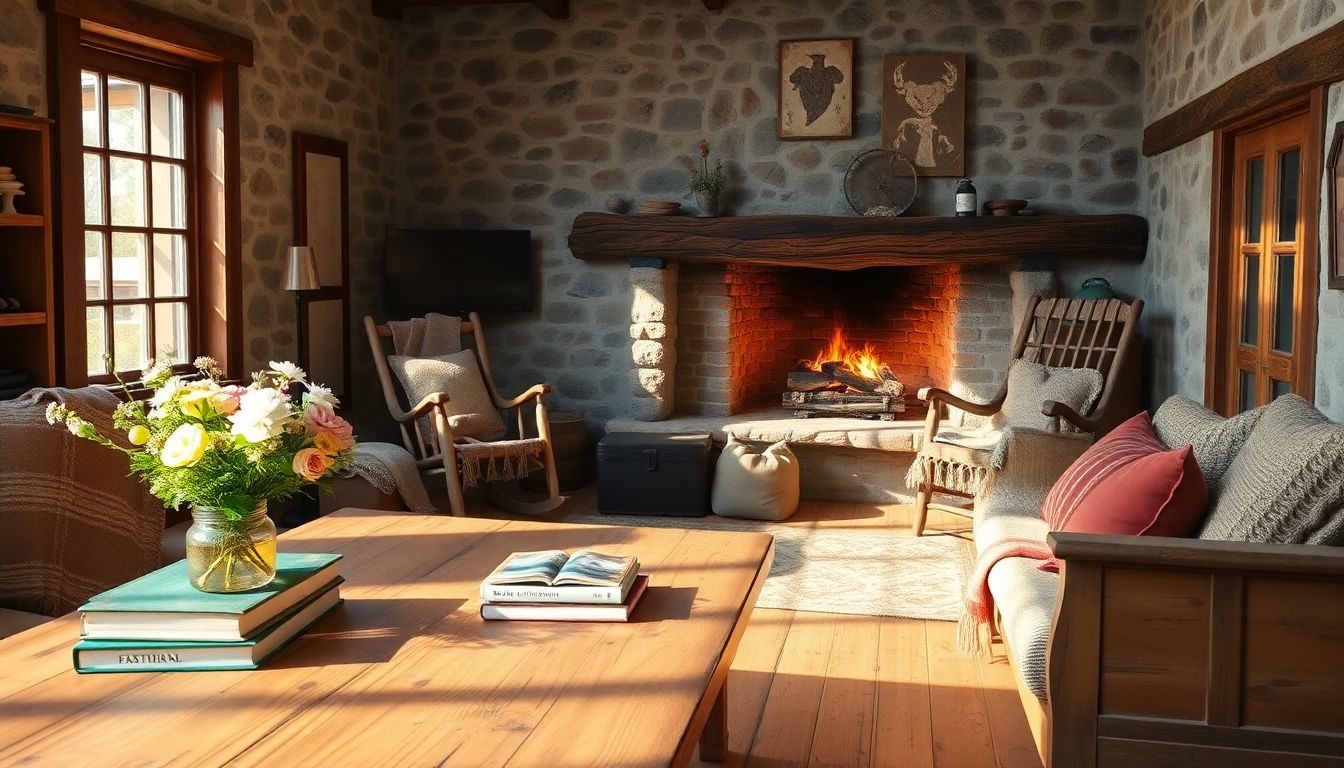
Embrace Rustic Charm: Your Guide to Rustic Home Decor
Imagine stepping into a cozy home where the smell of aged wood and the warmth of a crackling fire instantly put you at ease. Homes decorated in rustic style transport us back to simpler times, reminding us of nature’s beauty and tranquility. The rustic decor trend continues to capture hearts with its charm and warmth, making it a beloved choice for various spaces.
Rustic style showcases natural materials, weathered textures, and a timeless appeal. Characterized by its use of wood, stone, and earthy tones, rustic decor enhances the home’s character and comfort. This style can effortlessly adapt to different architectural designs, whether your home is a cottage, a farmhouse, or a modern space with rustic accents.
This guide will dive deep into how you can incorporate rustic elements into your home decor, helping you create a space full of charm and comfort.
Mastering the Fundamentals of Rustic Design
Understanding the Rustic Aesthetic
Rustic design finds its roots in rural landscapes and traditional craftsmanship. It often draws inspiration from nature, relying on materials that highlight the beauty of the outdoors. Core principles of rustic design include simplicity, authenticity, and the use of natural elements. The aesthetic emphasizes a warm, welcoming atmosphere that feels both lived-in and timeless.
Choosing a Rustic Style
There are various rustic sub-styles, each with its unique flair:
- Farmhouse Rustic: Focuses on simplicity, using vintage pieces and a neutral color palette.
- Cabin Rustic: Inspired by mountain retreats, featuring hearty woods and stone.
- Industrial Rustic: Combines the ruggedness of rustic design with modern, industrial elements.
Visual examples of these styles can be found in many design magazines or online platforms.
Color Palettes for Rustic Homes
The colors in rustic decor often draw from nature. You’ll find:
- Neutrals: Whites, creams, and browns create a soft, inviting backdrop.
- Earth Tones: Greens, rusts, and warm browns promote a grounded feel.
- Pops of Color: Touches of red or mustard yellow can add vibrancy without overwhelming the space.
Incorporating Natural Materials in Your Rustic Home
The Power of Wood
Wood is a cornerstone of rustic design. From exposed beams to reclaimed wood furniture, the versatility of wood is unmatched. According to statistics, wood flooring remains a popular choice among homeowners, often linked to its warmth and durability.
Stone and Brick Accents
Adding stone or brick can give your home character. Think about a stunning stone fireplace or a brick accent wall. These elements draw the eye and add texture. Well-executed stonework can become a masterpiece in your living space.
Textiles and Fabrics
Natural textiles enhance the rustic vibe. Fabrics like linen, cotton, and wool bring warmth and comfort. Brands like Pottery Barn and Anthropologie offer beautiful rustic textiles that can help you achieve the desired look with ease.
Rustic Furniture: Choosing Pieces that Tell a Story
Finding Authentic Rustic Furniture
Sourcing authentic rustic furniture is key. Antique shops and online marketplaces like Etsy are treasure troves for vintage finds. Look for pieces with character, such as distressed finishes or unique designs.
Mixing Modern and Rustic Furniture
Blending modern and rustic pieces can create a stunning contrast. For example, a sleek modern table can pair beautifully with rustic farm chairs. The combination brings together freshness and a charming heritage.
DIY Rustic Furniture Projects
Creating DIY rustic furniture infuses your personal touch into your space. Consider projects like building a farmhouse table or upcycling an old dresser. There are numerous resources online, including tutorials on platforms like Pinterest.
Lighting and Decor: Setting the Mood in Your Rustic Home
Rustic Lighting Options
Lighting plays a crucial role in setting the mood. Consider chandeliers made from wood or wrought iron. Pendant lights and table lamps crafted from natural materials can enhance the rustic feel. Brands like West Elm offer stylish lighting options that fit perfectly with the rustic theme.
Accentuating with Rustic Decor
Accessorizing is key to completing your rustic look. Incorporate artwork that reflects nature, lush plants, or metal accents for a layered appearance. Well-styled rustic spaces often include a mix of personal and sourced decor that tells a story.
Layering Textures and Patterns
In rustic design, texture and pattern bring visual interest. Combining different fabrics, like a chunky knit throw with a smooth linen pillow, creates depth. Successful layering techniques can keep the space feeling cozy and inviting.
Creating a Cozy and Functional Rustic Space
Incorporating Rustic Elements in Different Rooms
Every room in your home can benefit from rustic touches:
- Living Room: Add a wooden coffee table and cozy throw pillows.
- Bedroom: Use a reclaimed wood bed frame and soft linens.
- Kitchen: Incorporate wooden shelves and metal accents.
- Bathroom: Utilize stone tiles and vintage decor.
Design blogs have great examples of these implementations.
Maintaining a Balanced Rustic Look
A balanced rustic look is essential. Avoid clutter by selecting key pieces that truly speak to you. Essential organization tips include using baskets for storage and creating designated areas for items.
Expert Tips for a Successful Rustic Design
Interior designers emphasize that rustic design thrives on authenticity. Incorporating heirloom pieces or family mementos adds personal charm. As designer Sarah Richardson says, "Adding history to your home brings it to life."
Conclusion
In summary, rustic decor provides warmth and timeless appeal. From understanding the rustic aesthetic to incorporating natural materials, the journey towards a rustic home is rewarding. Keep in mind the versatility of rustic style; it can transform any space into a cozy retreat. Explore, experiment, and don’t be afraid to personalize your design.
Feel free to share your rustic decor experiences or ask questions in the comments below!





0 Comments